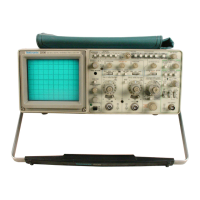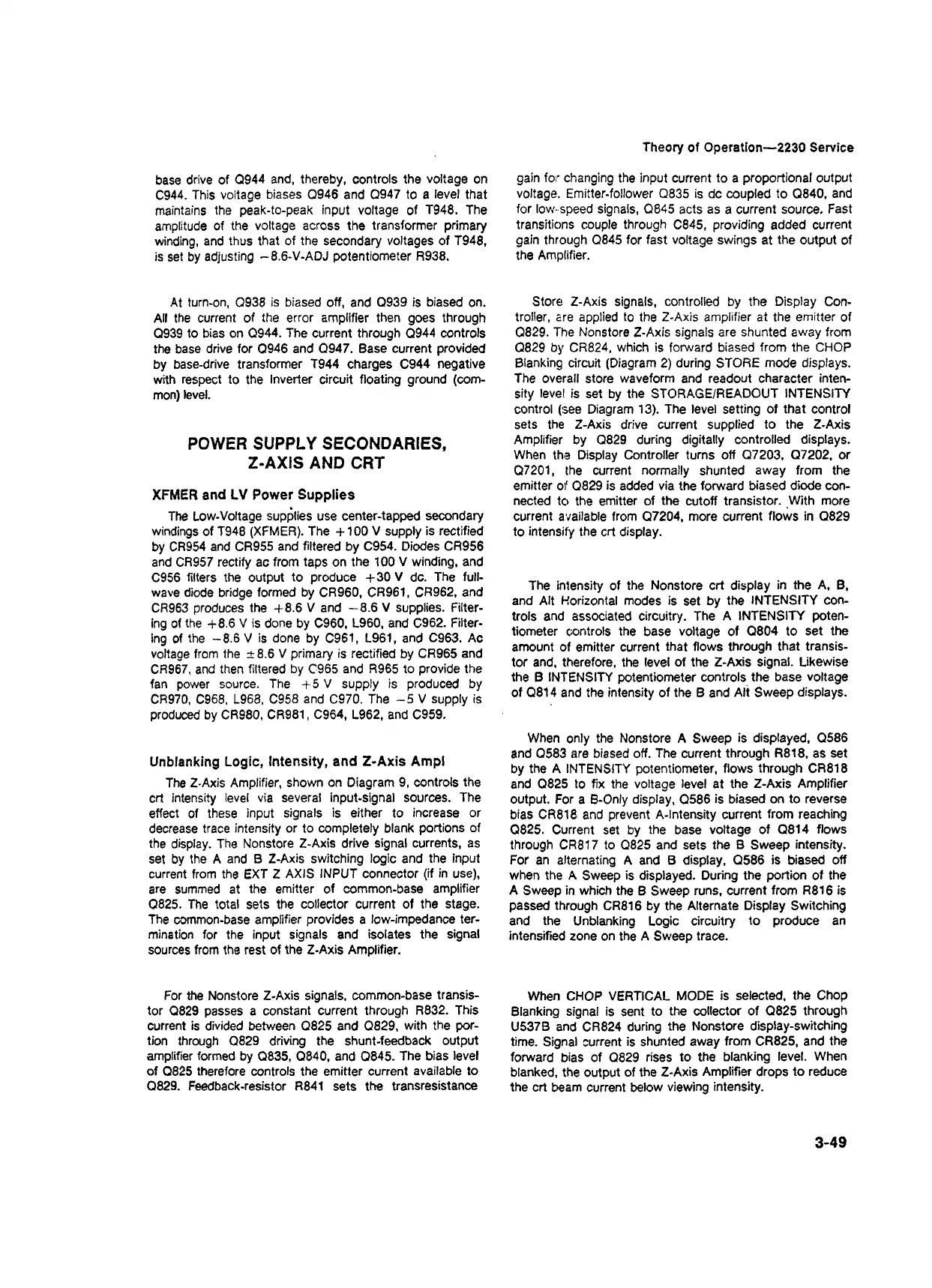Theory of Operation— 2230 Service
base drive of Q944 and, thereby, controls the voltage on
C944. This voltage biases Q946 and Q947 to a level that
maintains the peak-to-peak input voltage of T948. The
amplitude of the voltage across the transformer primary
winding, and thus that of the secondary voltages of T948,
is set by adjusting -8.6-V-ADJ potentiometer R938.
At turn-on, Q938 is biased off, and Q939 is biased on.
All the current of the error amplifier then goes through
Q939 to bias on Q944. The current through Q944 controls
the base drive for 0946 and Q947. Base current provided
by base-drive transformer T944 charges C944 negative
with respect to the Inverter circuit floating ground (com
mon) level.
POWER SUPPLY SECONDARIES,
Z-AXIS AND CRT
XFMER and LV Power Supplies
The Low-Voltage supplies use center-tapped secondary
windings of T948 (XFMER). The 4-100 V supply is rectified
by CR954 and CR955 and filtered by C954. Diodes CR956
and CR957 rectify ac from taps on the 100 V winding, and
C956 filters the output to produce +30 V dc. The full-
wave diode bridge formed by CR960, CR961, CR962, and
CR963 produces the +8.6 V and -8 .6 V supplies. Filter
ing of the +8.6 V is done by C960, L960, and C962. Filter
ing of the -8.6 V is done by C961, L961, and C963. Ac
voltage from the ± 8.6 V primary is rectified by CR965 and
CR967, and then filtered by 0965 and R965 to provide the
fan power source. The +5 V supply is produced by
CR970, C968, L968, C958 and C970. The -5 V supply is
produced by CR980, CR981, C964, L962, and C959.
Unblanking Logic, Intensity, and Z-Axis Ampl
The Z-Axis Amplifier, shown on Diagram 9, controls the
crt intensity level via several input-signal sources. The
effect of these input signals is either to increase or
decrease trace intensity or to completely blank portions of
the display. The Nonstore Z-Axis drive signal currents, as
set by the A and B Z-Axis switching logic and the input
current from the EXT Z AXIS INPUT connector (if in use),
are summed at the emitter of common-base amplifier
0825. The total sets the collector current of the stage.
The common-base amplifier provides a low-impedance ter
mination for the input signals and isolates the signal
sources from the rest of the Z-Axis Amplifier.
For the Nonstore Z-Axis signals, common-base transis
tor Q829 passes a constant current through R832. This
current is divided between Q825 and Q829, with the por
tion through Q829 driving the shunt-feedback output
amplifier formed by Q835, Q840, and 0845. The bias level
of Q825 therefore controls the emitter current available to
Q829. Feedback-resistor R841 sets the transresistance
gain for changing the input current to a proportional output
voltage. Emitter-follower Q835 is dc coupled to Q840, and
for low-speed signals, Q845 acts as a current source. Fast
transitions couple through C845, providing added current
gain through Q845 for fast voltage swings at the output of
the Amplifier.
Store Z-Axis signals, controlled by the Display Con
troller, are applied to the Z-Axis amplifier at the emitter of
Q829. The Nonstore Z-Axis signals are shunted away from
Q829 by CR824, which is forward biased from the CHOP
Blanking circuit (Diagram 2) during STORE mode displays.
The overall store waveform and readout character inten
sity level is set by the STORAGE/READOUT INTENSITY
control (see Diagram 13). The level setting of that control
sets the Z-Axis drive current supplied to the Z-Axis
Amplifier by Q829 during digitally controlled displays.
When the Display Controller turns off Q7203, Q7202, or
Q7201, (he current normally shunted away from the
emitter of Q829 is added via the forward biased diode con
nected to the emitter of the cutoff transistor. With more
current available from Q7204, more current flows in Q829
to intensity the crt display.
The intensity of the Nonstore crt display in the A, B,
and Alt Horizontal modes is set by the INTENSITY con
trols and associated circuitry. The A INTENSITY poten
tiometer controls the base voltage of Q804 to set the
amount of emitter current that flows through that transis
tor and, therefore, the level of the Z-Axis signal. Likewise
the B INTENSITY potentiometer controls the base voltage
of Q814 and the intensity of the B and Ait Sweep displays.
When only the Nonstore A Sweep is displayed, Q586
and Q583 are biased off. The current through R818, as set
by the A INTENSITY potentiometer, flows through CR818
and Q825 to fix the voltage level at the Z-Axis Amplifier
output. For a B-Only display, Q586 is biased on to reverse
bias CR818 and prevent A-Intensity current from reaching
Q825. Current set by the base voltage of Q814 flows
through CR817 to Q825 and sets the B Sweep intensity.
For an alternating A and B display, Q586 is biased off
when the A Sweep is displayed. During the portion of the
A Sweep in which the B Sweep runs, current from R816 is
passed through CR816 by the Alternate Display Switching
and the Unblanking Logic circuitry to produce an
intensified zone on the A Sweep trace.
When CHOP VERTICAL MODE is selected, the Chop
Blanking signal is sent to the collector of Q825 through
U537B and CR824 during the Nonstore display-switching
time. Signal current is shunted away from CR825, and the
forward bias of Q829 rises to the blanking level. When
blanked, the output of the Z-Axis Amplifier drops to reduce
the crt beam current below viewing intensity.
3-49

